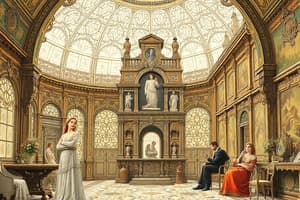Podcast
Questions and Answers
What was the primary artistic goal of the Age of Louis XIV?
What was the primary artistic goal of the Age of Louis XIV?
- To imitate classical antiquity (correct)
- To promote anti-Renaissance ideals
- To glorify the state and king (correct)
- To develop emotional intensity in art
Which composer is associated with the Baroque lifestyle?
Which composer is associated with the Baroque lifestyle?
- Moliere
- Johann Sebastian Bach (correct)
- Francois Couperin
- Jean Baptiste Lully (correct)
What is the time frame of the Baroque Period?
What is the time frame of the Baroque Period?
1600-1750
Mannerist painting is characterized by symmetry and harmony.
Mannerist painting is characterized by symmetry and harmony.
Who were the major painters of the Baroque lifestyle?
Who were the major painters of the Baroque lifestyle?
The War of _____ Succession was fought from 1701 to 1713.
The War of _____ Succession was fought from 1701 to 1713.
What was one significant outcome of the Treaty of Paris related to the Seven Years War?
What was one significant outcome of the Treaty of Paris related to the Seven Years War?
The 18th Century is often referred to as the Century of _____
The 18th Century is often referred to as the Century of _____
Which event led to France entering the French Revolution?
Which event led to France entering the French Revolution?
Flashcards are hidden until you start studying
Study Notes
Age of Louis XIV
- Characterized by the imitation of classical antiquity and Renaissance ideals.
- Art served to glorify the state and the king, influencing music and theater as ceremonial backdrops.
- Prominent figures include:
- Jean Baptiste Lully - known for ballet and opera.
- Francois Couperin - influential in keyboard music.
- Marc-Antoine Charpentier - noted for religious compositions.
- Moliere - renowned for satirical comedies such as "Tartuffe."
- Jean Racine - focused on tragic dramas drawing from Greek/Roman themes, like "Phaedre."
- French language gained prominence, supplanted Latin in international scholarship and diplomacy.
Baroque Period (1600-1750)
- Marked by dramatic shifts from Renaissance aesthetics and an embrace of Baroque artistic expression.
- Associated with the image of an odd-shaped, imperfect pearl symbolizing complexity.
- Predominantly flourished in Catholic countries as a reaction to Renaissance and Reformation upheavals.
- Context included a disunited Christendom and societal turmoil stemming from religious conflicts.
Mannerist Painting
- Defined as an anti-Renaissance movement, emphasizing twisted and contoured figures.
- Notable for emotional intensity, clashing colors, and asymmetric compositions.
- El Greco was a significant figure, known for his works based in Toledo, Spain.
Baroque Lifestyle
- Characterized by tension, grandeur, and opulence.
- Prominent artists include:
- Peter Paul Rubens - known for his depictions of pagan and pre-Christian themes.
- Diego Velazquez - court painter famed for his portraits of Hapsburg royalty.
- Dutch masters captured the prosperity of urban life, showcasing:
- Franz Hals - celebrated for portraits of commoners.
- Jan Vermeer - recognized for intimate, photographic-like interiors.
- Rembrandt - known for exploring dramatic and psychological themes.
- Transition in architecture towards more elaborate, emotional designs, moving away from Renaissance balance and symmetry.
- Notable architects include:
- Palladio - Italian influence on classical styles.
- Bernini - creator of the dramatic colonnade at St. Peter's Square.
- Music evolved with opera as a significant entertainment form, with composers like:
- Monteverdi - known for opulent and dramatic works.
- Johann Sebastian Bach - celebrated for emotional compositions in both secular and religious contexts.
18th Century: Century of Warfare
- War of Spanish Succession (1701-1713): Conflict over the Spanish throne involving France and Spain against the Alliance of Hague, concluded with the Treaty of Utrecht.
- War of Polish Succession (1733-1735): French efforts to control the Polish throne met with opposition from other powers, resulting in Augustus becoming king.
- War of Austrian Succession (1740-1748): Triggered by Frederick the Great's invasion of Silesia; concluded with the Treaty of Aix-la-Chapelle granting Prussia control of Silesia.
- Seven Years War (1756-1763): A global conflict including the French and Indian War; ended with the Treaty of Paris, which removed France from North America.
- American Revolution (1776-1783): Revolt of American colonies against England leading to U.S. independence with the Treaty of Paris, which offered no gains for France.
- French Revolution (1789): Catalyzed by financial distress, marking a significant upheaval in France's political landscape.
Studying That Suits You
Use AI to generate personalized quizzes and flashcards to suit your learning preferences.




